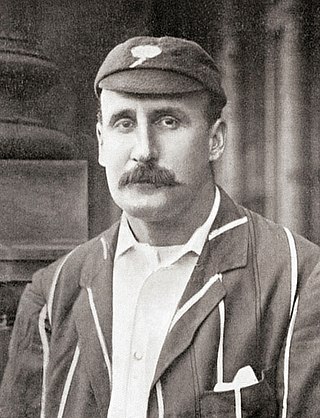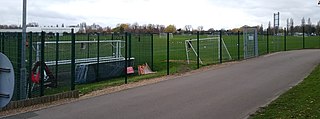
Marylebone Cricket Club (MCC) is a cricket club founded in 1787 and based since 1814 at Lord's Cricket Ground, which it owns, in St John's Wood, London. The club, formerly the governing body of cricket, retains considerable global influence.

Lord's Cricket Ground, commonly known as Lord's, is a cricket venue in St John's Wood, London. Named after its founder, Thomas Lord, it is owned by Marylebone Cricket Club (MCC) and is the home of Middlesex County Cricket Club, the England and Wales Cricket Board (ECB), the ICC Europe and, until August 2005, the International Cricket Council (ICC). Lord's is widely referred to as the Home of Cricket and is home to the world's oldest sporting museum.

Martin Bladen Hawke, 7th Baron Hawke, generally known as Lord Hawke, was an English amateur cricketer active from 1881 to 1911 who played for Yorkshire and England. He was born in Willingham by Stow, near Gainsborough, Lincolnshire, and died in Edinburgh. He appeared in 633 first-class matches, including five Test matches, as a righthanded batsman, scoring 16,749 runs with a highest score of 166 and held 209 catches. He scored 13 centuries and 69 half-centuries.

Thomas Lord was an English professional cricketer who played first-class cricket from 1787 to 1802. He made a brief comeback, playing in one further match in 1815. Overall, Lord made 90 known appearances in first-class cricket. He was mostly associated with Middlesex and with Marylebone Cricket Club (MCC) as a ground staff bowler.

In cricket, a century is a score of 100 or more runs in a single innings by a batter. The term is also included in "century partnership" which occurs when two batsmen add 100 runs to the team total when they are batting together. A century is regarded as a landmark score for batters and a player's number of centuries is generally recorded in their career statistics. Scoring a century is loosely equivalent in merit to a bowler taking a five-wicket haul, and is commonly referred to as a ton or hundred. Scores of more than 200 runs are still statistically counted as a century, although these scores are referred to as double, triple, and quadruple centuries, and so on. Reaching 50 runs in an innings is known as a half-century.

The Queen's Park Oval is a sports stadium in Port of Spain, Trinidad and Tobago, used mostly for cricket matches. It opened in 1896. Privately owned by the Queen's Park Cricket Club, it is currently the second largest capacity cricket ground in the West Indies with seating for about 20,000 spectators.
Broadhalfpenny Down is a historic cricket ground in Hambledon, Hampshire. It is known as the "Cradle of Cricket" because it was the home venue in the 18th century of the Hambledon Club, but cricket predated the club and ground by at least two centuries. The club is in the parish of Hambledon close to the neighbouring parish of Clanfield. The club took the name of the neighbouring rural village of Hambledon, about 2.7 miles away by road.

Herbert Tremenheere Hewett was an English amateur first-class cricketer who played for Somerset, captaining the county from 1889 to 1893, as well as Oxford University and the Marylebone Cricket Club. A battling left-handed opening batsman, Hewett could post a large score in a short time against even the best bowlers. Capable of hitting the ball powerfully, he combined an excellent eye with an unorthodox style to be regarded at his peak as one of England's finest batsmen.
County cricket teams representing Middlesex have been traced back to the 18th century, although for long periods the county was secondary to the London Cricket Club which played at the Artillery Ground. Middlesex teams played at various grounds throughout what is now the Greater London area. Islington and Uxbridge were often used but home matches were also played on Kennington Common and in Berkshire. Middlesex teams were less frequent in the 19th century until 1859 when the Walker family of Southgate became involved in county cricket.

The 1787 cricket season in England is noteworthy for the foundation of Marylebone Cricket Club (MCC) after the opening of Thomas Lord's first ground in the parish of Marylebone, north of London. MCC soon became the sport's governing body with the new ground as its feature venue. The first match known to have been played at Lord's was on Monday, 21 May, between the White Conduit Club and a Middlesex county team. The first match known to involve a team representing MCC was against White Conduit on Monday, 30 July. Including these two, reports and/or match scorecards have survived of numerous eleven-a-side matches played in 1787. Eleven are retrospectively, but unofficially, recognised as first-class.

The Australia national cricket team toured England in 1884. The team is officially termed the Fourth Australians, following three previous tours in the 1878, 1880 and 1882 seasons. The 1884 tour was a private venture by the thirteen players who each invested an agreed sum to provide funding, none of Australia's colonial cricket associations being involved. Billy Murdoch captained the team and George Alexander acted as player-manager. The Australians played a total of 32 matches in England, 31 of which have first-class status.
Prince's Cricket Ground in Chelsea, London was a cricket ground, created by the brothers George and James Prince as part of the Prince's Club, on which 37 first-class matches were played between 1872 and 1878. The ground was built on in 1883. The boundaries of the site, laid out on the former Cattleugh's nursery gardens, are marked by Cadogan Square West, Milner Street, Lennox Gardens Mews, Walton Street and Pont Street.
Lord's Old Ground was a cricket venue in London that was established by Thomas Lord in 1787. It was used mainly by Marylebone Cricket Club for major matches until 1810, after which a dispute about rent caused Lord to relocate.
James Rice was an English amateur cricketer during the Napoleonic Wars.
The United South of England Eleven (USEE) was an itinerant cricket team founded in November 1864 by Edgar Willsher, as secretary, and John Lillywhite, as treasurer. The USEE had no home venue as its prime purpose, like all similarly named teams of the time, was to operate as a travelling show and bring top-class cricket to places in Great Britain and Ireland which rarely received it. Fourteen USEE matches have been recognised by CricketArchive as first-class, mostly against the rival United North of England Eleven (UNEE). The USEE is estimated to have played 217 "odds" matches as a visiting team against local club sides which generally used 22 players.

Lansdown Cricket Club Ground is the cricket grounds in Bath, Somerset. Between 1825 and 1850, it was the name given to Lansdown Cricket Club's (LCC) ground 'Cricket Down'. In 1850, LCC moved to Sydenham Field, also in Bath. In 1869 the club moved again, and the name was then used for their 'Combe Park' ground, where they have played ever since.

King's House Sports Ground is a multi-use sports ground in Chiswick, London. King George V presided over the official opening in 1926 and inspected the teams. The first recorded cricket match on the ground was in 1926, when the Civil Service cricket team played Australia in a non first-class match. The following year, the ground held its only first-class match when the Civil Service played the touring New Zealanders. This match was also the Civil Service's only appearance in first-class cricket.
Chiswick Park Cricket Ground was a cricket ground in Chiswick, London. The first recorded match on the ground was in 1886, when Chiswick Park played the Parsees during their tour of England.

Lord Hawke selected a cricket team of ten amateurs and two professional players to tour Australia and New Zealand from November 1902 until March 1903. After an opening game in San Francisco, the tour began of eighteen matches - seven of them considered first-class - in New Zealand followed by three further first-class games in Australia. Hawke's team was the first to tour Australasia with New Zealand as the primary destination and, as was the norm at the time, was privately run and funded. The Australian leg of the tour was a "profit making venture", however the games in New Zealand were scheduled at the behest of the New Zealand Cricket Board in order to raise the profile of cricket in the country. Two of them were against a New Zealand cricket team, before its international Test status. The inclusion of such games on the tour were considered "a sign that cricket in New Zealand was starting to be taken more seriously, and a move towards official international status was possible."
Through the Napoleonic Wars, county cricket virtually died as cricket was impacted by losses of investment and manpower.











